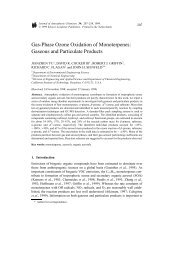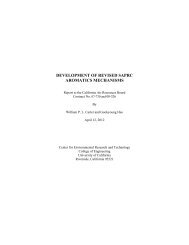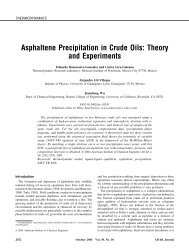Density functional theory for chemical engineering: From capillarity ...
Density functional theory for chemical engineering: From capillarity ...
Density functional theory for chemical engineering: From capillarity ...
Create successful ePaper yourself
Turn your PDF publications into a flip-book with our unique Google optimized e-Paper software.
As observed in experiments, DFT predicts that, at a given<br />
temperature, the vapor–liquid surface tension of a polymeric<br />
fluid declines with the chain length or the polymer molecular<br />
weight (Figure 5). Numerical results from DFT also suggest<br />
that at the vapor–liquid interface of a mixture containing deuterated<br />
and protonated polymers of the same length, the deuterated<br />
component always partitions preferentially to the interface,<br />
but when the protonated chains are much shorter than<br />
those of the deuterated chains, the protonated chains are enriched<br />
at the interface. These predictions are in good agreement<br />
with neutron reflectivity and second-ion mass spectrometry<br />
experiments. 107 In addition, DFT captures the accumulation of<br />
branched chains at the vapor–liquid surface in a mixture of<br />
linear and branched polymers with the same number of repeating<br />
units. For the effect of segment-size disparity on surface<br />
segregation, DFT correctly predicts a strong surface enhancement<br />
of the chains with the larger segment. The predictions of<br />
DFT <strong>for</strong> the vapor–liquid interfacial tensions of ionic fluids and<br />
ionic melts are also in good agreement with simulation and<br />
experimental results. 110<br />
Figure 4. Surface tension of polydimethylsiloxane (PDMS)<br />
from DFT (lines) and from experiment (symbols).<br />
(A) The effect of temperature on surface tension <strong>for</strong> two<br />
monodisperse fractions of PDMS with molecular weights<br />
32,000 and 770 Daltons, respectively. (B) The surface tension<br />
of a PDMS blend vs. the weight fraction of the low molecular<br />
weight polymer. The experimental data are from Dee and<br />
Sauer 113 and the lines are calculated by Kierlik et al. 107<br />
achieved by application of the renormalization group <strong>theory</strong>. 106<br />
Despite some discrepancy between <strong>theory</strong> and experiment <strong>for</strong><br />
the densities of liquid water and methanol resulting from the<br />
simplicity of the molecular model, DFT is able to correlate the<br />
bulk and interfacial properties at all temperatures in a selfconsistent<br />
manner. The theoretical description of surface properties<br />
is much more demanding than that <strong>for</strong> bulk properties<br />
because it is necessary to consider the spatial inhomogeneity.<br />
For this reason, conventional phenomenological models often<br />
require additional interface-specific parameters.<br />
A similar DFT can be used to predict the vapor–liquid<br />
interfacial properties of polymeric, 107,108 ionic, 109-111 and surfactant<br />
systems. 112 For example, Figure 4 shows the temperature<br />
dependency of the surface tension of polydimethylsiloxane<br />
(PDMS) calculated from a generalized first-order perturbation<br />
<strong>theory</strong>. 107 Agreement of the <strong>theory</strong> with experiment is excellent<br />
<strong>for</strong> both monodisperse polymers as well as <strong>for</strong> blends over a<br />
wide range of temperature. Although similar per<strong>for</strong>mance<br />
might be achieved based on a conventional phenomenological<br />
<strong>theory</strong> such as the square-gradient <strong>theory</strong>, 113 in contrast to<br />
DFT, a phenomenological model requires an analytic equation<br />
of state <strong>for</strong> bulk fluids and a few parameters to account <strong>for</strong><br />
interfacial inhomogeneity. Moreover, the square-gradient <strong>theory</strong><br />
is unable to capture the nonmonotonic density profiles<br />
across the vapor–liquid interface near the triple point or the<br />
surface segregation effects arising from branching, segment<br />
size, and isotopic substitutions.<br />
Liquid–liquid interface<br />
Demixing of a liquid mixture may occur at both high and<br />
low temperatures. For a binary liquid mixture consisting of<br />
nonpolar molecules of similar size, demixing occurs only below<br />
an upper critical solution temperature (UCST). However,<br />
the situation is much more complicated if the molecules of two<br />
Figure 5. (A) Reduced surface tension vs. the degree of<br />
polymerization predicted by DFT; 107 (B) surface<br />
tension of PDMS vs. number-averaged<br />
molecular weight W n .<br />
In (A) m is the number of repeating units in each molecule<br />
represented by a tangent chain of Lennard–Jones (LJ) spheres,<br />
and are the LJ parameters, and T* k B T/.<br />
1176 March 2006 Vol. 52, No. 3<br />
AIChE Journal
















